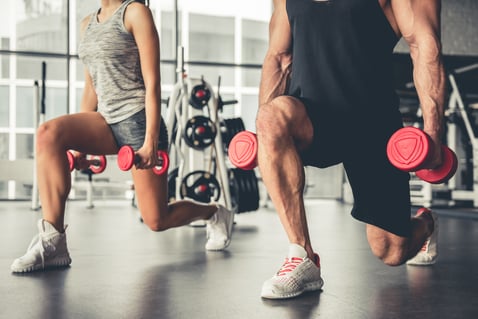While combining activities or exercises for greater benefit is not an entirely new idea—think alternating push-ups with jumping jacks—the fitness industry has seen a tremendous recent growth in high-intensity-interval-training (HIIT) in a variety of forms. One of the key concepts in this method of exercise is combining movements or alternating between two types of work through intervals for greater benefit. The incredible human body will respond to this by getting stronger, faster and more coordinated through the various movements. Another advantage to this type of training is time savings with the ability to target a variety of benefits in one workout.
For the purpose of this article we will keep the focus on strength specifically and how to get even better results from combining one or more strength movements—known as ‘compound exercises.’ There are a variety of ways to combine movements with one primary approach including a lower body move in combination with an upper body, effectively creating a ‘total body’ movement. Squats and lunges may be done along with upper body moves to increase balance, control, coordination and, ultimately, functional strength that repeats the moves we make in real life activities.
As a first introduction to compound movements, a squat-press or squat-reach is a great starting point. With feet parallel and spaced to approximate hip-width (feet in line with bones protruding from front of hips), sit back with the hips, keeping knees behind toes, into a semi- or deep-squat with knees not exceeding 90-degrees. As you come up out of the squat position, continue up into an overhead reach with both hands and elevate the heels slightly off the floor so you are on the balls of your feet. After a very brief (1-count) pause, lower the hands/arms and sit back into the squat position. Be sure to keep a slight bend in the knees even in the upright, reaching position and keep lower abs tight with the breath out on the way up into the reach/press. Repeat for a set of twelve repetitions or more for an excellent total body warm-up. Dumbbells, medicine balls or other types of external resistance may then be added to this exercise to increase the demand on the upper and lower body.
Lunges have a slightly different rule than squats for the knees with the goal of keeping the knees from going out over the foot or laces of the shoes.

This holds true whether combined with other exercises or done alone. As the stance is staggered with a lunge we are already in a less stable position than a squat so we want to be sure to maintain the same hip-width foot alignment as above for best stability. From a lunge position, the back foot may be brought forward to a kickstand position beside the other foot (while getting used to the move) or taken up into balance position with the back leg elevated, knee in a 90-degree angle at approximate waist level.
A common compound addition to a lunge is a biceps curl and/or curl into overhead press. Starting in a lunge position with weights held adjacent to the sides with arms straight down and palms rotated toward sides of body, step up into balance position while curling on both sides. Step forward into the next lunge then up into balance, taking the curled arms up into an overhead press, rotating the palms forward as you move from the curl into the press.
These two examples open many other combination/compounding possibilities with the goal always being to maintain stability by progressing from easier to harder modifications of the moves. Some other basics include squat-jumps for lower body strength and plyometric benefit, squat-press into a lunge and vice versa. Stay tuned for transverse plane modifications of these in the next edition of this post. In the meantime, ask a Personal Trainer about how to take your exercises to the next level through compound work. Try Team Training at The Alaska Club and see some of the techniques described in action. Exploring moves is great but ensuring you have the knowledge and instruction if you are in doubt is also a valuable way to make sure you are on the right track. Be well.


